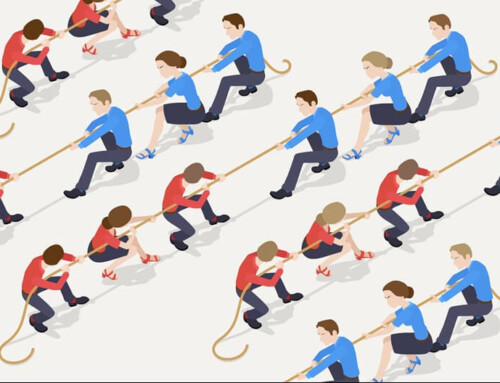Working in sales isn’t always an easy job. Sales professionals are faced with a wide range of obstacles, and are well-acquainted with rejection, disappointment, and failure. But what are the specific obstacles that show up most frequently, and what are the best ways to overcome them? Here are some of the greatest hindrances to a salesperson’s work, and the best ways to succeed in spite of these obstacles.
Giving Up
Any sales job requires determination, but given the amount of rejection a salesperson faces it can be easy for them to lose heart. It takes an average of 8 cold calls to reach a prospect, so it’s easy for a salesperson to give up prematurely. Studies show that 80% of sales require 5 follow-up calls, but 44% of sales reps give up after just one follow-up call. Sales teams won’t thrive if salespeople bow out prematurely. 1
If you want to avoid this, make sure salespeople have the right expectations. Don’t let them assume that a single follow-up will be sufficient, or that prospects who don’t respond on the first try aren’t interested. Furthermore, make sure that you’re promoting a culture of recognition and working to keep morale high.
Productivity Issues
One of the biggest obstacles salespeople face is productivity issues. Recent Richardson research found that 49% of the salespeople they spoke to believe the biggest work challenge is spending too much time on non-sales activity.2 Other research would agree: sales reps spend only 36.6% of their time actually selling!3
Hindrances to productivity come in a variety of forms. Some salespeople may be distracted by internet/app/mobile use, while others lack the guidelines necessary to foster good productivity. Sales teams need clear direction, leadership invested in the team’s effort and morale, and accountability.
Lack of Skills
Another obstacle to successful selling is a lack of skill. Research conducted by Caliper suggests that 55% of salespeople don’t have the skills it takes to be successful in their work.4 Similarly, 26% of sales professional respondents in a Richardson study said they didn’t know how to team sell effectively.5 How can a sales team thrive if its individual members lack the skills or knowledge necessary to perform excellent work?
This is why training is so vital. Continuous training can give 50% higher net sales per employee!6) Don’t just view training as something necessary for new hires—it benefits everyone, and every salesperson will be helped by your continued investment in their knowledge and skills. Additionally, sales professionals need to be aware of, develop relationships with, and be trained to include key supporting team members as part of the sales process. For example:
- Technical – answering questions about the product specifications, how it can integrate with existing products/services, design or scope assistance, etc.
- Marketing – messaging, refining sales messages based upon buyer personas, clearer understanding of the buying cycle by industry and customer, etc.
- Accounting – how to provide financing options or shift budgets to afford the purchase, determining customer risk, etc.
- Purchasing – identifying alternative vendors, working to negotiate rebate or discounted pricing, etc.
- Production – clarifying schedules, defining how items are produced or services, etc.
Failure to Address Client’s Needs
A salesperson’s success can also be hindered by a failure to address their client’s needs. A study by Impact Communications found that 70% of purchasing decisions are made to solve a specific problem.7 However, research by Josiane Feigon suggests only 13% of customers can understand their needs!8 A salesperson must accurately identify their client’s needs and then provide a means of meeting that need. If your sales team can’t do that, their chances of making sales are pretty minimal.
So how do you address this? Make sure your business focuses on meeting customer needs, not just your own bottom line. Salespeople must prioritize their clients, and must learn how to press in and figure out their customers’ needs. Your sales team must be equipped to ask the right questions.
Leads Aren’t Nurtured
Sometimes sales success is hindered by a failure to nurture leads. A Demand Gen Report survey found that nurtured leads typically result in 20% more sales opportunities than non-nurtured leads.9 If a company doesn’t put enough time into their buyer relationships at every step of the buyer’s journey, sales success is much less likely.
Marketing and sales need to join forces if they want fruitful buyer relationships. They need to figure out a way to determine where each lead is within their buying model, and provide quality content that meets the lead’s most pressing needs.
Conclusion
Sales work can be incredibly frustrating at times, but it’s helpful to identify the biggest obstacles and consider possible solutions. The best sales teams will not be defeated by these obstacles, but will instead work hard to overcome them.
Are you looking to improve your sales team’s morale or productivity? Talk to Gavel International our travel incentive programs.
1http://blog.thebrevetgroup.com/21-mind-blowing-sales-stats
2https://www.richardson.com/sales-resources/2017-selling-challenges/
3https://acceleratethebusiness.clickfunnels.com/sales-page-17452197
4http://www.calipereurope.com/portfolio/job-matching-for-better-sales-performance/
5https://www.richardson.com/sales-resources/2017-selling-challenges/
6http://blog.thebrevetgroup.com/21-mind-blowing-sales-stats
7https://www.propellercrm.com/blog/sales-statistics
8https://www.insidesales.com/insider/sales-metrics/16-sales-training-statistics/
9https://www.propellercrm.com/blog/sales-statistics
This article was last updated on May 30, 2025
- 4 Tips for Preserving Company Culture and Morale While Scaling Up - June 23, 2025
- Revitalize Meetings with Engaging Breakout Sessions - June 9, 2025
- Reconsider Best Practices Before They Leave Your Business Stranded - May 26, 2025






